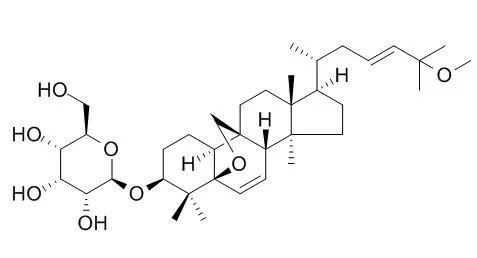| Structure Identification: |
| Tetrahedron Letters.1982; 23(1):77-80. | | Structures of momordicosides F1, F2, G, I, K and L, novel cucurbitacins in the fruits of Momordica charantia L.[Reference: WebLink] |
METHODS AND RESULTS:
Two bitter cucurbitacins, momordicosides K and L, and four non-bitter cucurbitacins, momordicoside F1, momordicoside F2, Momordicoside G and momordicoside I, were isolated from the immature fruits of Momordica charantia L. (Cucurbitaceae) and their structures were elucidated. | | J. Agric. Food Chem., 2007, 55 (14), pp 5827–5833. | | Effects of Processing Methods on the Proximate Composition and Momordicosides K and L Content of Bitter Melon Vegetable[Reference: WebLink] | Bitter melon (Mormodica charantia L.) has been associated with health benefits such as hypoglycemic, antiatherogenic, and anti-HIV activities. The vegetable, however, has an unpleasant bitter taste.
The purpose of this research was to establish the effect of various processing methods on the moisture, lipid, and protein content of the Sri Lanka variety of bitter melon and to determine the effect of the processing methods on momordicosides K and L contents.
METHODS AND RESULTS:
The processing methods used were frying, blanching, sun drying, oven drying, freeze drying, and bitter masking with five different commercial bitter masking agents. Moisture, lipid, and protein analyses were done using standard AACC methods. Drying decreased moisture content from 92% to 9.5−10.2%. Frying lowered moisture content to 0.8% while increasing lipid content from 3.6 to 67%. Protein content remained unaffected by treatments.
CONCLUSIONS:
A liquid chromatography−electrospray ionization−mass spectrometry (LC/ESI/MS) method was used to identify momordicosides K and L in methanolic extracts of fresh and processed samples. Only extracted ion chromatographs for blanched bitter melon and bitter melon with MY 68 agent showed the absence of momordicosides K and L. |
|






 Cell. 2018 Jan 11;172(1-2):249-261.e12. doi: 10.1016/j.cell.2017.12.019.IF=36.216(2019)
Cell. 2018 Jan 11;172(1-2):249-261.e12. doi: 10.1016/j.cell.2017.12.019.IF=36.216(2019) Cell Metab. 2020 Mar 3;31(3):534-548.e5. doi: 10.1016/j.cmet.2020.01.002.IF=22.415(2019)
Cell Metab. 2020 Mar 3;31(3):534-548.e5. doi: 10.1016/j.cmet.2020.01.002.IF=22.415(2019) Mol Cell. 2017 Nov 16;68(4):673-685.e6. doi: 10.1016/j.molcel.2017.10.022.IF=14.548(2019)
Mol Cell. 2017 Nov 16;68(4):673-685.e6. doi: 10.1016/j.molcel.2017.10.022.IF=14.548(2019)